An Investigation into the Effects of Primary School Building Forms on Campus Wind Environment and Classroom Ventilation Performance
Abstract
:1. Introduction
2. Research Methods
2.1. Typical Models of School Buildings
- (1)
- Using Statistical Package for the Social Sciences (SPSS) 29.0.1.0 analysis, survey data and the mean, median, and mode values of each group of data are obtained.
- (2)
- The mean, median, and mode values of each data set are compared to determine their relative magnitudes. When the mean, median, and mode are equal, the data distribution is normal, and the mean represents the typical value for that dataset. When the mean is greater than the median and the median is greater than the mode, or when the mean is less than the median and the median is less than the mode, the data distribution is skewed. In this case, the median or mode is considered the representative value. A tiny discrepancy between the median and mode has a minimal effect on the calculation outcome, allowing the average of the two to be considered the typical value. If there is a notable difference between the two, the skewed distribution of the data in that group is transformed into a normal distribution, and the average is then considered the typical value. When the order of magnitude of these three values differs or there are multiple mode values, a normality and skewness test is conducted on the data in that group before establishing the typical value.
- (3)
- SPSS commonly uses the Shapiro–Wilk (S–W) and Kolmogorov–Smirnov (K–S) tests to assess normality. The Shapiro–Wilk test is appropriate for sample sizes below 5000 and the Kolmogorov–Smirnov test is acceptable for sample sizes over 5000. If the p-value is less than 0.05, the data in that group are deemed to not adhere to a normal distribution; otherwise, they do. If the mean, median, and mode are not equal, and the p-value is more than 0.05, the data in that group can be said to follow a normal distribution.
2.2. Case Study
2.3. CFD Simulations
3. Simulation Results and Analysis
3.1. External Simulation Results for Winter
3.2. External Simulation Results for Summer
3.3. Internal Simulation Results
4. Discussion
4.1. The Correlation between Indoor Air Exchange Rate and Wind Pressure Differential across Exterior Building Windows
4.2. Comprehensive Evaluation of Four Scenarios
5. Conclusions
- (1)
- Regardless of the scenario adopted, in the downtown area, due to the dense surrounding buildings, there is a certain degree of wind obstruction and a deceleration effect on the prevailing wind, ensuring that the outdoor wind speed in winter can meet comfort requirements.
- (2)
- The adoption of row-by-row floor planning results in the best performance in both indoor and outdoor wind environments. This is primarily because, under the condition of the average outdoor wind speed being within the comfort range, row-by-row floor planning allows the wind to easily traverse the entire site, effectively improving indicators such as outdoor wind speed, wind speed amplification factor, vortex areas, and still wind areas. At the same time, it also facilitates indoor air exchange rates and wind speed.
- (3)
- The scenario with zigzag floor planning performed the worst, primarily because the building form significantly obstructs the wind, preventing it from continuing to flow after entering the building. This negatively impacts indicators such as outdoor wind speed, wind pressure difference between the windward and leeward façades of the building, and indoor wind speed. Branching floor planning is similar to zigzag floor planning, but it breaks down the larger semi-enclosed spaces in zigzag floor planning, increasing the likelihood of the wind continuing to flow. Therefore, its performance is better.
- (4)
- When adopting enclosed floor planning, it is necessary to leave gaps on the windward and leeward sides to ensure airflow within the enclosed space. However, due to the funneling effect within the gaps, the wind speed may increase. Therefore, the gaps should be as large as possible.
Author Contributions
Funding
Institutional Review Board Statement
Informed Consent Statement
Data Availability Statement
Conflicts of Interest
References
- Tan, X.; Zhang, Y.; Shao, H. Healthy China 2030, a breakthrough for improving health. Glob. Health Promotion 2019, 26, 96–99. [Google Scholar] [CrossRef] [PubMed]
- GB/T 51356-2019; Green Campus Evaluation Standard. China Construction Industry Press: Beijing, China, 2019.
- Li, Y. Green Building Design: Wind Environment of Building; Tongji University Press: Shanghai, China, 2014. [Google Scholar]
- Qian, F.; Yang, L. Green campus environmental design based on sustainable theory. J. Clean Energy Technol. 2018, 6, 159–164. [Google Scholar] [CrossRef]
- Yang, L.; Liu, X.; Qian, F.; Niu, S. Research on the wind environment and air quality of parallel courtyards in a university campus. Sustain. Cities Soc. 2020, 56, 102019. [Google Scholar] [CrossRef]
- Sadrizadeh, S.; Yao, R.; Yuan, F.; Awbi, H.; Bahnfleth, W.; Bi, Y.; Li, B. Indoor air quality and health in schools: A critical review for developing the roadmap for the future school environment. J. Build. Eng. 2022, 57, 104908. [Google Scholar] [CrossRef]
- Wu, Y.; Wu, S.; Qiu, X.; Wang, S.; Yao, S.; Li, W.; Guo, Y. Integrated evaluation method of the health-related physical environment in urbanizing areas: A case study from a university campus in China. Front. Public Health 2022, 10, 801023. [Google Scholar] [CrossRef]
- Nag, P.K.; Nag, P.K. Sick building syndrome and other building-related illnesses. Off. Build. Health Saf. Environ. 2019, 53–103. [Google Scholar]
- Liu, S.; Pan, W.; Cao, Q.; Long, Z.; Jiang, Y.; Chen, Q. CFD simulations of natural cross ventilation through an apartment with modified hourly wind information from a meteorological station. Energy Build. 2019, 195, 16–25. [Google Scholar] [CrossRef]
- He, Y.; Schnabel, M.A.; Mei, Y. A novel methodology for architectural wind environment study by integrating CFD simulation, multiple parametric tools and evaluation criteria. Build. Simul. 2020, 13, 609–625. [Google Scholar] [CrossRef]
- Hong, B.; Lin, B. Numerical studies of the outdoor wind environment and thermal comfort at pedestrian level in housing blocks with different building layout patterns and trees arrangement. Renew. Energy 2015, 73, 18–27. [Google Scholar] [CrossRef]
- Blocken, B.; Carmeliet, J.; Stathopoulos, T. CFD evaluation of wind speed conditions in passages between parallel buildings—Effect of wall-function roughness modifications for the atmospheric boundary layer flow. J. Wind Eng. Ind. Aerodyn. 2007, 95, 941–962. [Google Scholar] [CrossRef]
- Awol, A.; Bitsuamlak, G.T.; Tariku, F. Numerical estimation of the external convective heat transfer coefficient for buildings in an urban-like setting. Build. Environ. 2020, 169, 106557. [Google Scholar] [CrossRef]
- Hunter, L.J.; Johnson, G.T.; Watson, I.D. An investigation of three-dimensional characteristics of flow regimes within the urban canyon. Atmos. Environ. Part B Urban Atmos. 1992, 26, 425–432. [Google Scholar] [CrossRef]
- Kubota, T.; Miura, M.; Tominaga, Y.; Mochida, A. Wind tunnel tests on the relationship between building density and pedestrian-level wind velocity: Development of guidelines for realizing acceptable wind environment in residential neighborhoods. Build. Environ. 2008, 43, 1699–1708. [Google Scholar] [CrossRef]
- Mittal, H.; Sharma, A.; Gairola, A. Numerical simulation of pedestrian level wind flow around buildings: Effect of corner modification and orientation. J. Build. Eng. 2019, 22, 314–326. [Google Scholar] [CrossRef]
- Driss, S.; Driss, Z.; Kammoun, I.K. Numerical simulation and wind tunnel experiments on wind-induced natural ventilation in isolated building with patio. Energy 2015, 90, 917–925. [Google Scholar] [CrossRef]
- Ghaffarianhoseini, A.; Berardi, U.; Ghaffarianhoseini, A. Thermal performance characteristics of unshaded courtyards in hot and humid climates. Build. Environ. 2015, 87, 154–168. [Google Scholar] [CrossRef]
- Passe, U.; Battaglia, F. Designing Spaces for Natural Ventilation: An Architect’s Guide; Routledge: London, UK, 2015. [Google Scholar]
- Smith, P.F. Architecture in a Climate of Change, 1st ed.; Routledge: London, UK, 2001. [Google Scholar]
- Xie, X.; Sahin, O.; Luo, Z.; Yao, R. Impact of neighborhood-scale climate characteristics on building heating demand and night ventilation cooling potential. Renew. Energy 2020, 150, 943–956. [Google Scholar] [CrossRef]
- Wang, Z.; Gao, Y.; Meng, Q.; Zhao, L.; Jin, L. Research on the Relationship between Building Complex Layout and Natural Ventilation. Build. Sci. 2007, 23, 24–27+75. [Google Scholar]
- Gan, T.; Ying, X.; Shen, J. Design of Primary School Campus Layout Form Based on Wind Environment Optimization. Archit. Cult. 2019, 4, 110–111. [Google Scholar]
- Niu, J.; Liu, J.; Lee, T.C.; Lin, Z.J.; Mak, C.; Tse, K.T.; Kwok, K.C. A new method to assess spatial variations of outdoor thermal comfort: Onsite monitoring results and implications for precinct planning. Build. Environ. 2015, 91, 263–270. [Google Scholar] [CrossRef]
- Xu, X.; Wu, Y.; Wang, W.; Hong, T.; Xu, N. Performance-driven optimization of urban open space configuration in the cold-winter and hot-summer region of China. Build. Simul. 2019, 12, 411–424. [Google Scholar] [CrossRef]
- Liu, K.; Xu, X.; Zhang, R.; Kong, L.; Wang, W.; Deng, W. Impact of urban form on building energy consumption and solar energy potential: A case study of residential blocks in Jianhu, China. Energy Build. 2023, 280, 112727. [Google Scholar] [CrossRef]
- GB 50099-2011; Code for Design of Primary and Secondary Schools. China Construction Industry Press: Beijing, China, 2011.
- Peng, Z.; Deng, W.; Tenorio, R. An integrated low-energy ventilation system to improve indoor environment performance of school buildings in the cold climate zone of China. Build. Environ. 2020, 182, 107153. [Google Scholar] [CrossRef]
- Peng, Z.; Cheng, Y.; Jiang, M.; Shu, S.; Geng, X. Potential combination strategies to establish a low-energy ventilation system for school buildings in the cold climate zone of China—A demand-oriented review. J. Build. Eng. 2023, 76, 107065. [Google Scholar] [CrossRef]
- Sun, H. Discussion on the application of natural ventilation technology in primary and secondary school architectural design. China’s New Technol. Prod. 2011, 2, 270. [Google Scholar]
- Gong, C.; Wang, X. Research on the Impact of Architectural Layout on the Wind Environment of Residential Communities. Build. Sci. 2014, 30, 6–12. [Google Scholar]
- Wang, D.; Zhang, J.; Ji, X.; Tian, G.; Liu, W. Optimization design of a university’s planning scheme based on PHOENICS simulation. Jiangsu Archit. 2016, 003, 9–11. [Google Scholar]
- Xu, Y.; Zhang, G.; Yan, C.; Wang, G.; Jiang, Y.; Zhao, K. A two-stage multi-objective optimization method for envelope and energy generation systems of primary and secondary school teaching buildings in China. Build. Environ. 2021, 204, 108142. [Google Scholar] [CrossRef]
- Wang, H.; Chen, S.; Tang, J. Numerical simulation and analysis of wind environment in group buildings. Mech. Pract. 2006, 28, 14–18. [Google Scholar]
- Yuan, J.; Yuan, J.; Miao, Y. The impact of multi-story building layout on wind environment in mountainous conditions. J. Shenyang Jianzhu Univ. (Nat. Sci. Ed.) 2021, 37, 330–337. [Google Scholar]
- Liang, T.; He, R.; Chen, K.; Tian, G. Research on the Effect of Campus Green Space Layout on Microclimate. J. Henan Agric. Univ. 2017, 51, 414–420. [Google Scholar]
- GB/T 50378-2019; Green Building Evaluation Standard. China Construction Industry Press: Beijing, China, 2019.
- Son, S.; Jang, C.M. Air ventilation performance of school classrooms with respect to the installation positions of return duct. Sustainability 2021, 13, 6188. [Google Scholar] [CrossRef]
- Gong, N.; Tham, K.W.; Melikov, A.K.; Wyon, D.P.; Sekhar, S.C.; Cheong, K.W. The acceptable air velocity ranges for local air movement in the tropics. HVAC&r Res. 2006, 12, 1065–1076. [Google Scholar]
- Khedari, J.; Yamtraipat, N.; Pratintong, N.; Hirunlabh, J. Thailand ventilation comfort chart. Energy Build. 2000, 32, 245–249. [Google Scholar] [CrossRef]
- Rohles, F.H. The effects of air movement and temperature on the thermal sensations of sedentary man. ASHRAE Trans. 1974, 80, 101–119. [Google Scholar]
- Cândido, C.; De Dear, R.J.; Lamberts, R.; Bittencourt, L. Air movement acceptability limits and thermal comfort in Brazil’s hot humid climate zone. Build. Environ. 2010, 45, 222–229. [Google Scholar] [CrossRef]
- Huang, L.; Ouyang, Q.; Zhu, Y.; Jiang, L. A study about the demand for air movement in warm environment. Build. Environ. 2013, 61, 27–33. [Google Scholar] [CrossRef]
- Chen, G. LVJIANSWARE: Be a pioneer in building simulation technology. China Constr. Informatiz. 2018, 19, 64–65. [Google Scholar]
- Xi’an Statistics Bureau. Xi’an Statistical Yearbook 2023; Xi’an Statistics Bureau: Xi’an, China, 2023. [Google Scholar]




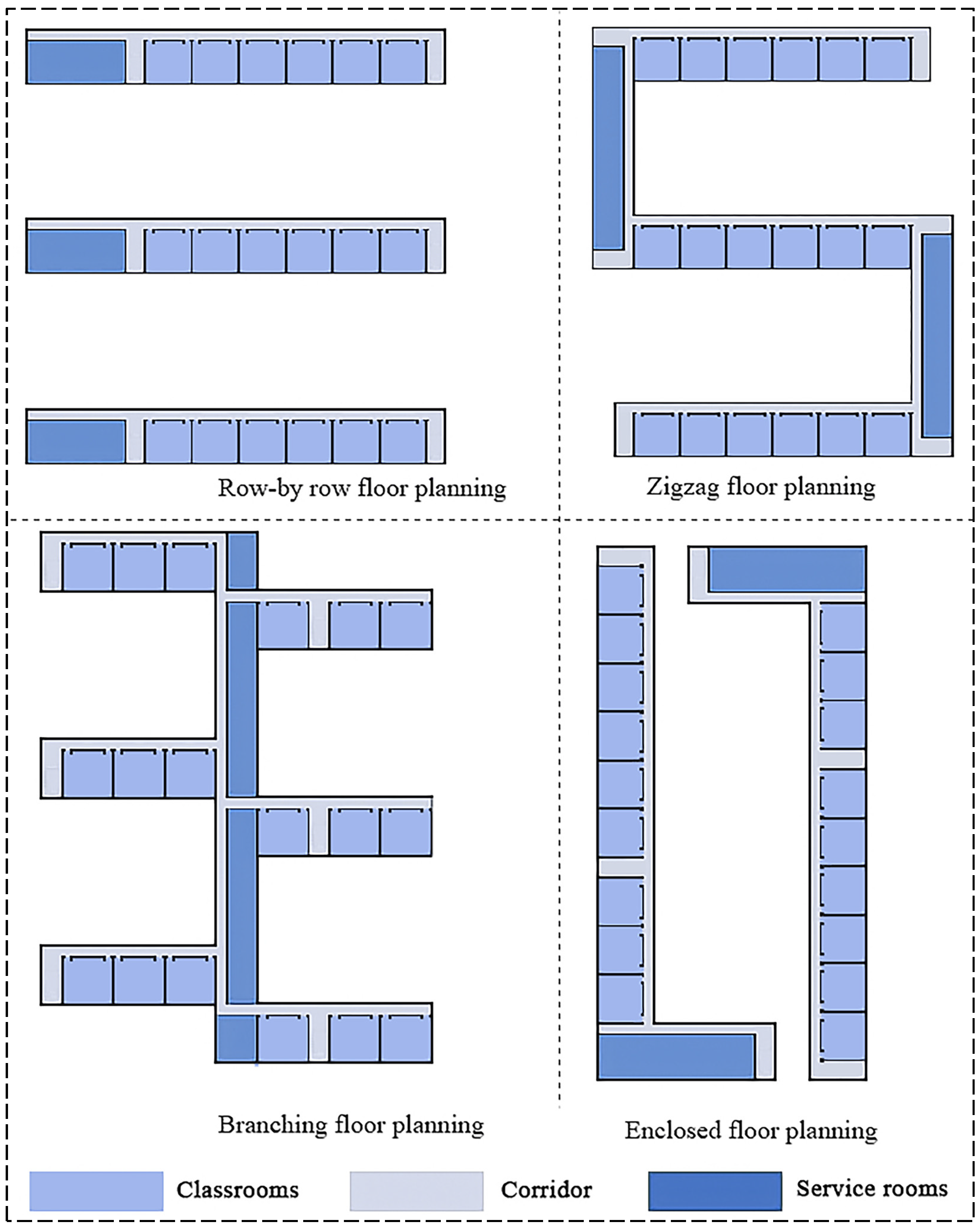
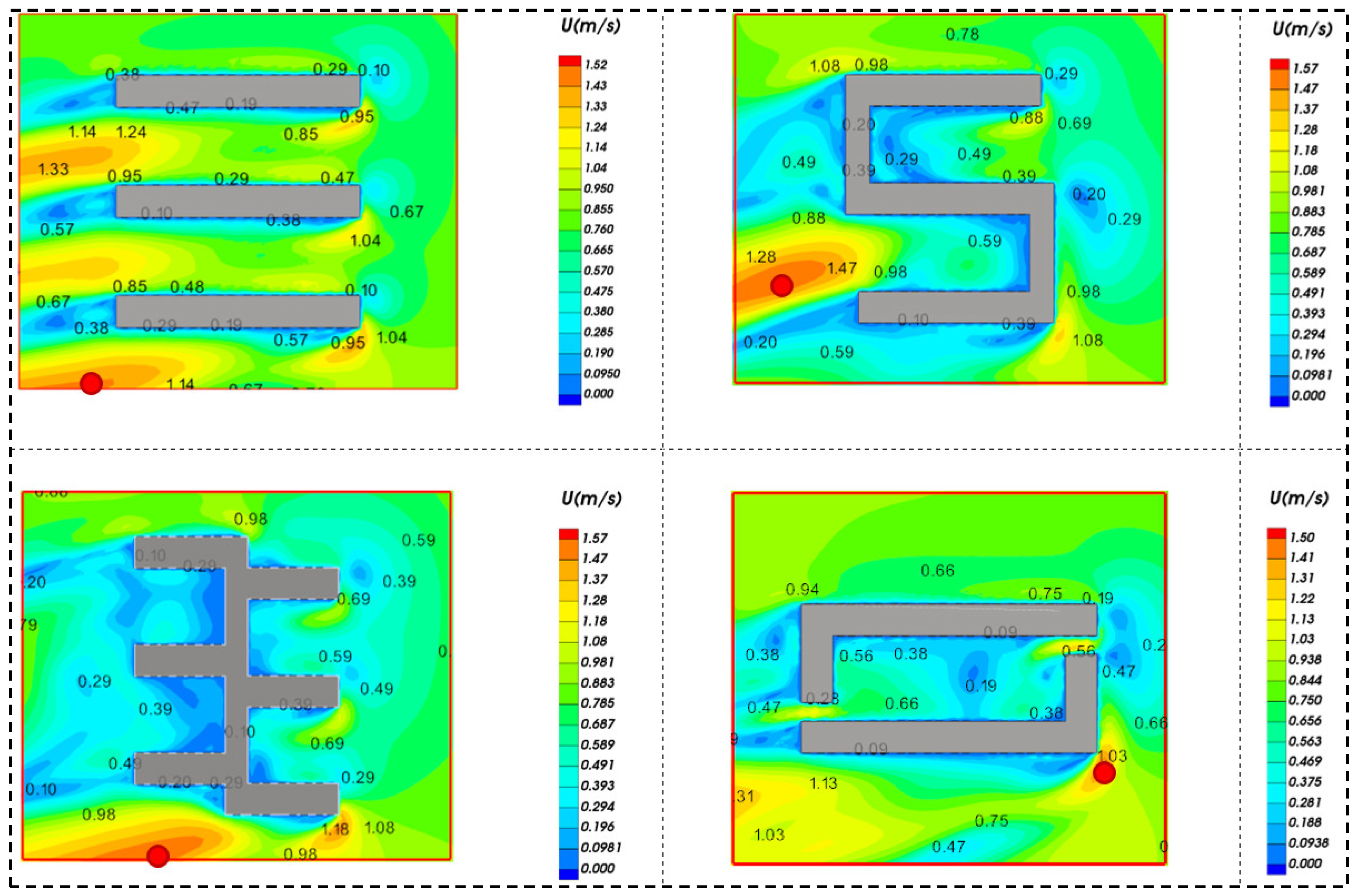
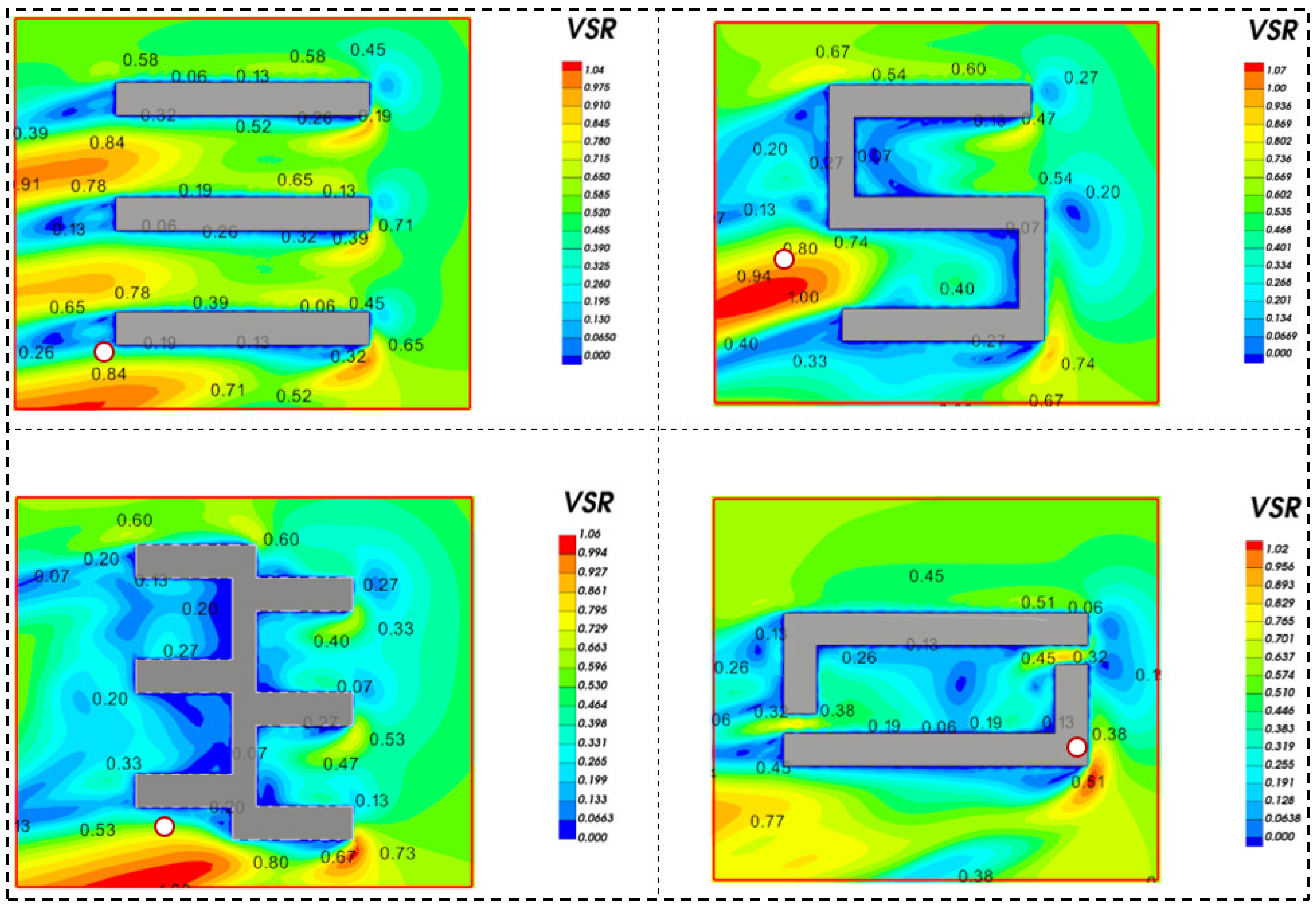
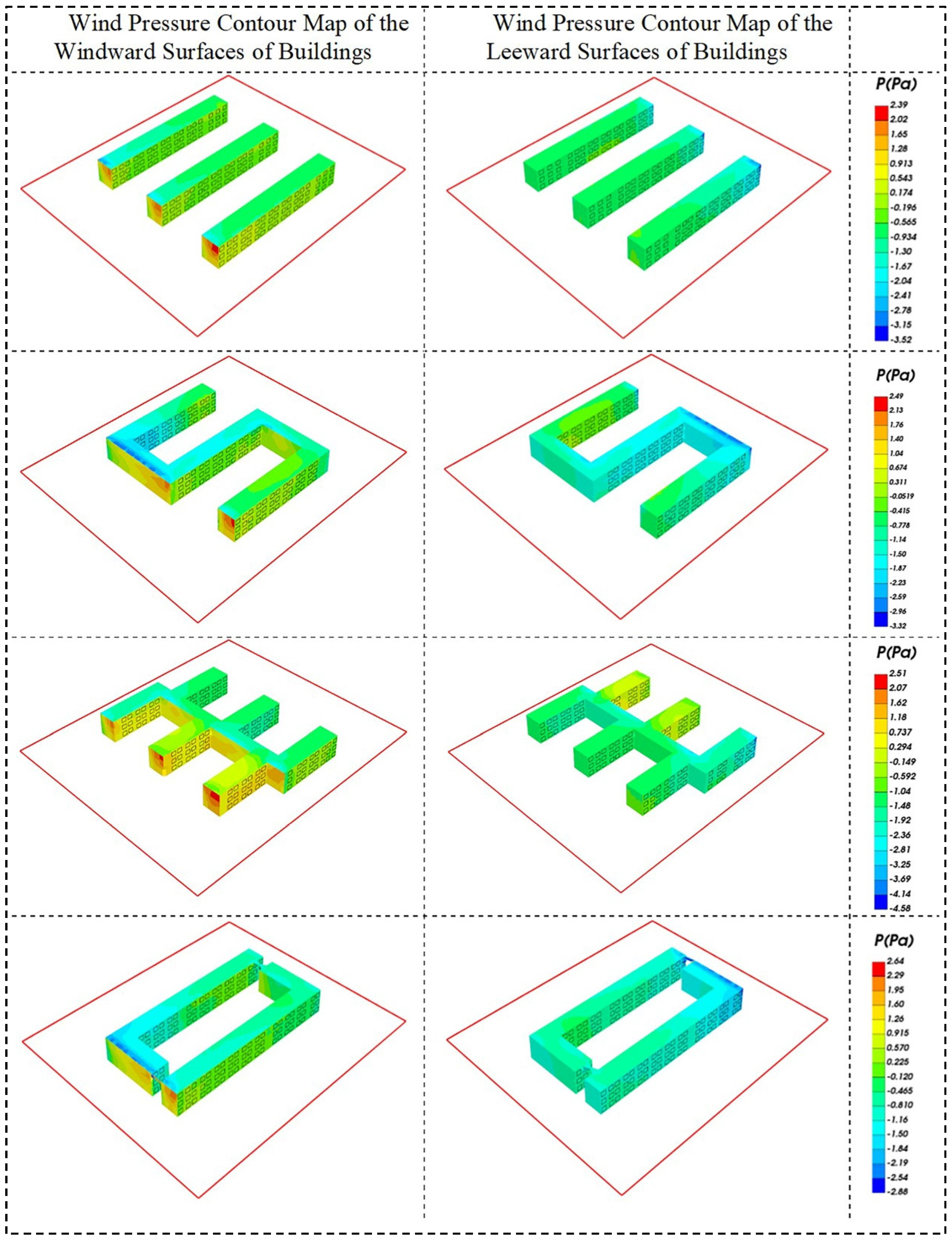
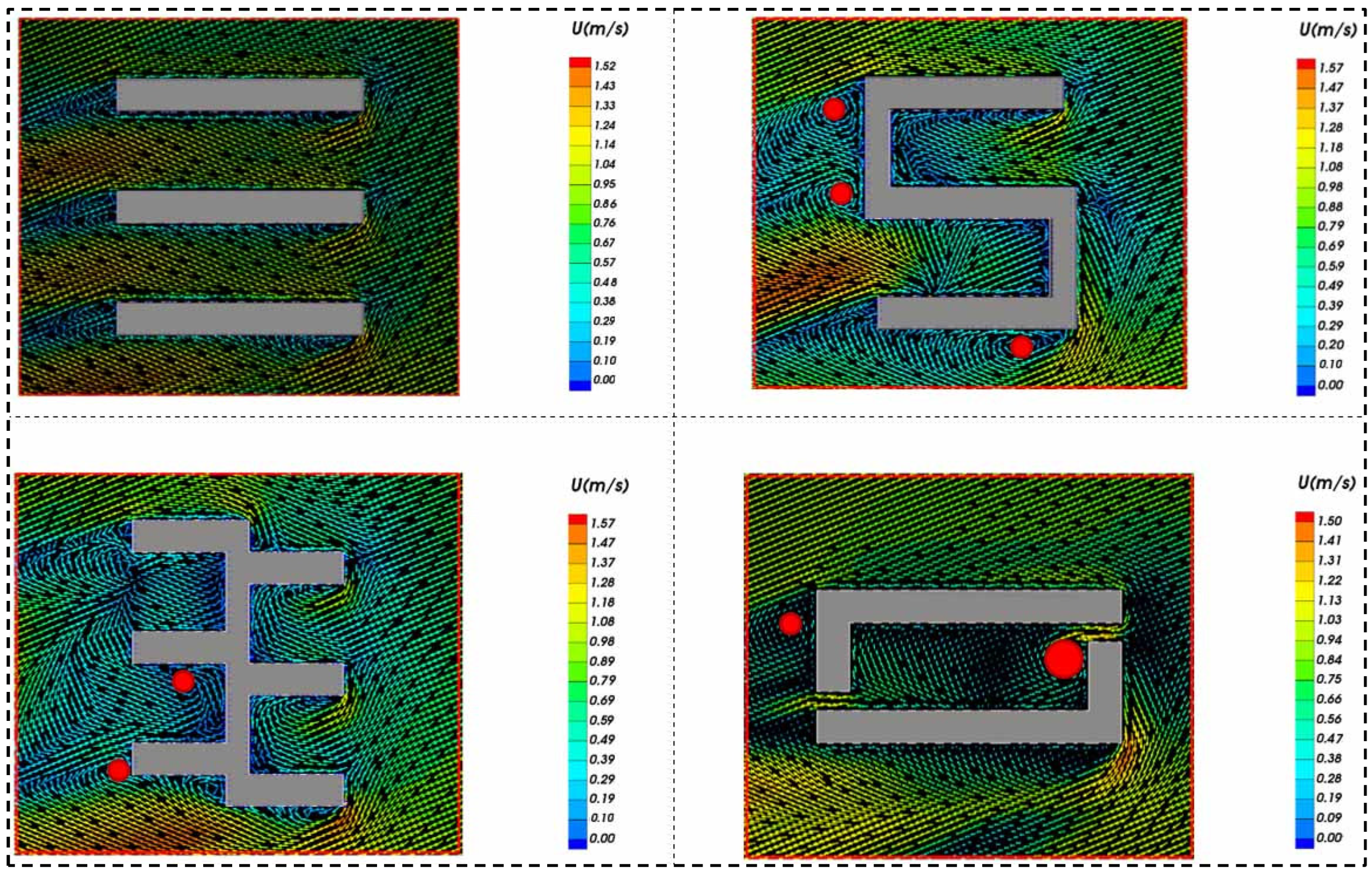


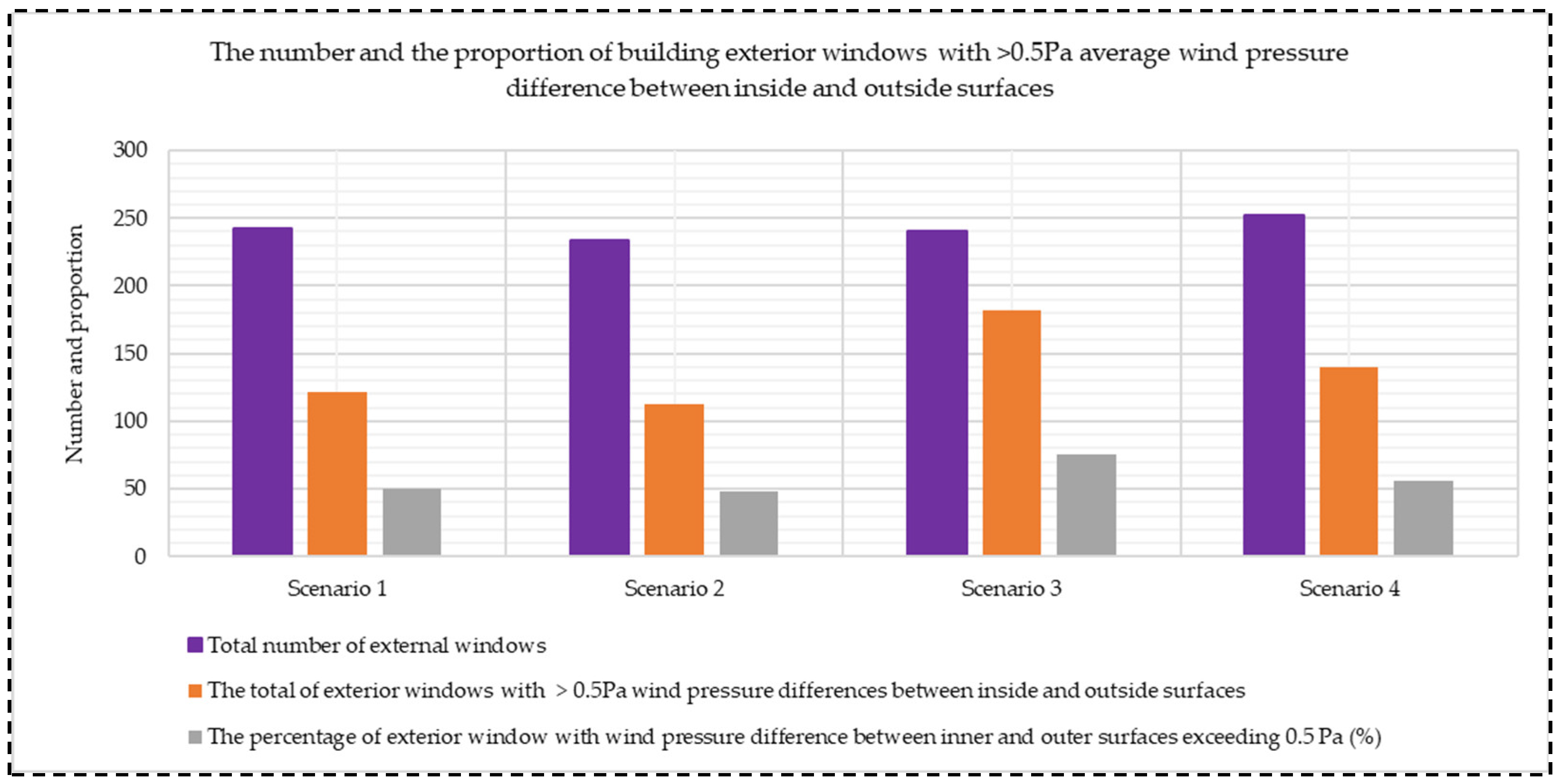
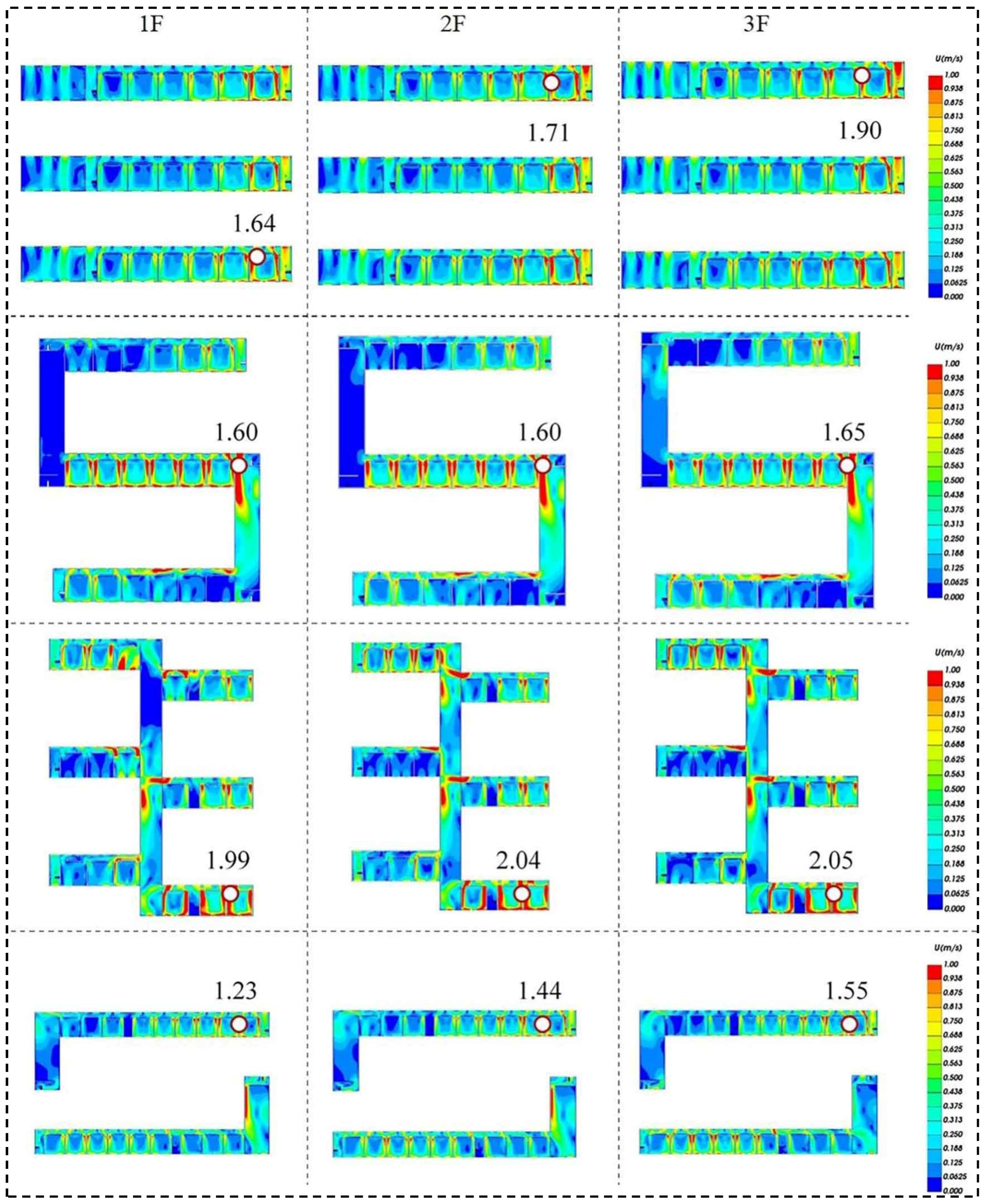

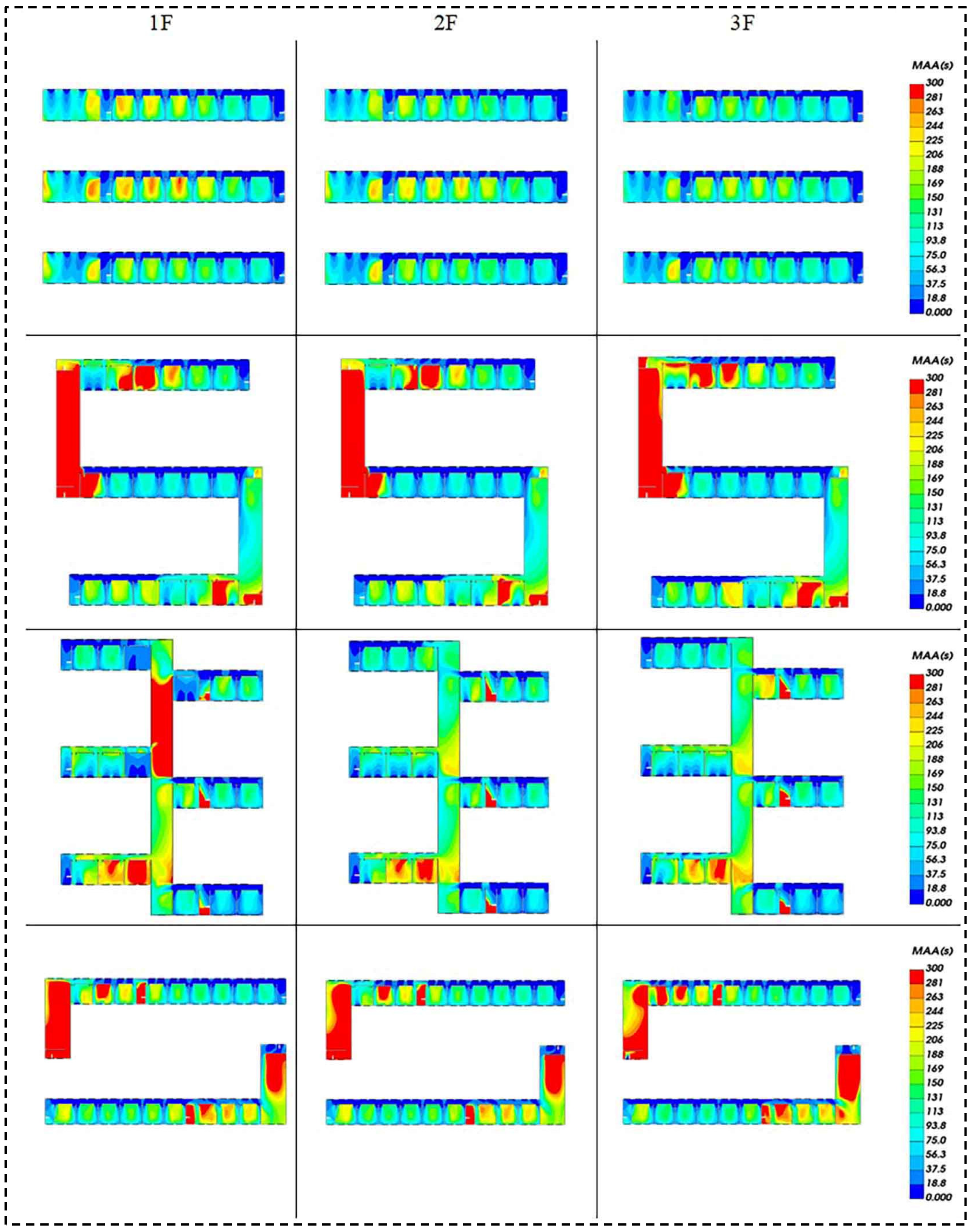
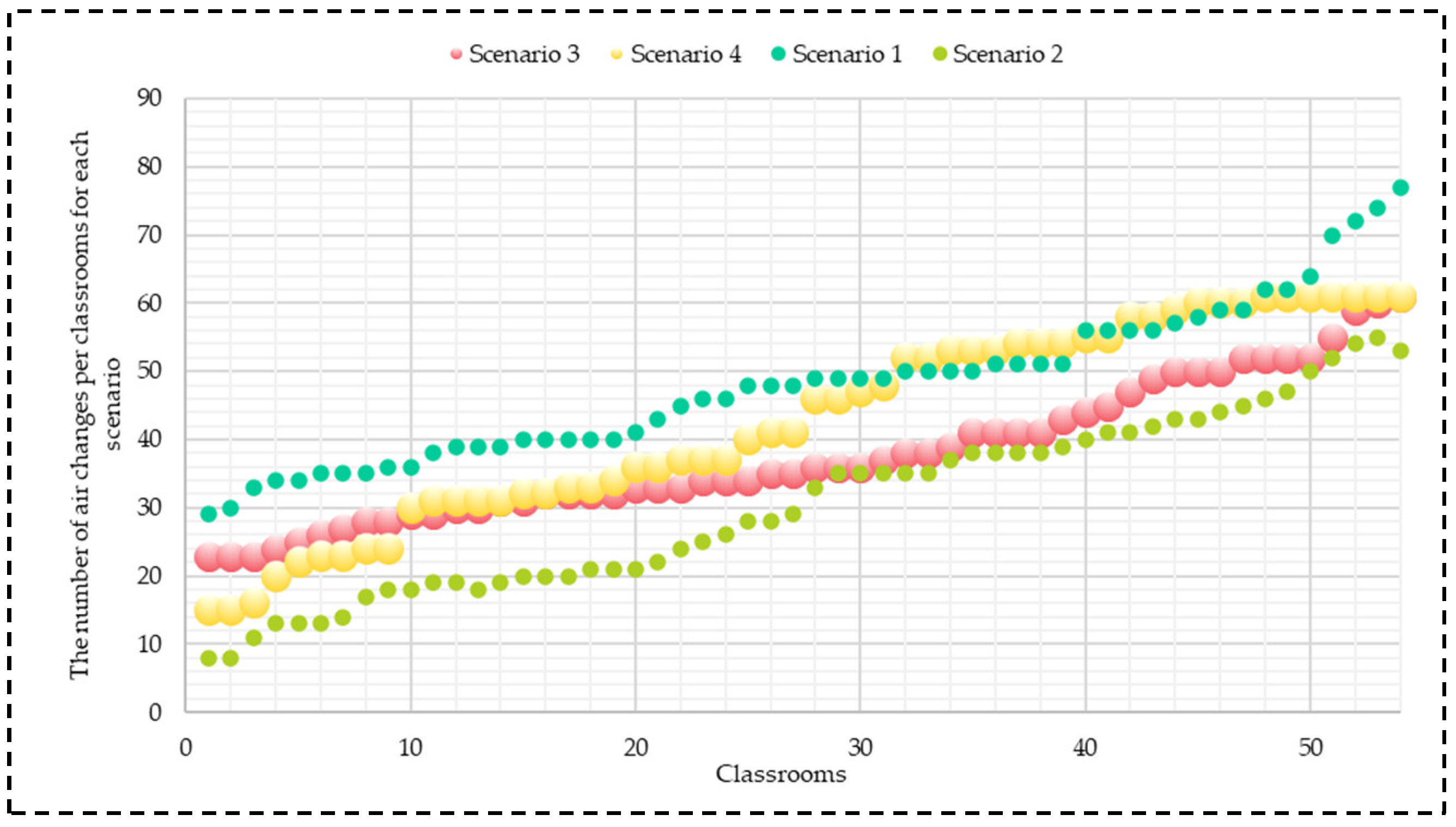



| Shape Coefficient | Window-to-Wall Ratios | ||||
|---|---|---|---|---|---|
| Southern | Western | Northern | Eastern | ||
| Mean | 0.26 | 0.32 | 0.25 | 0.33 | 0.22 |
| Median | 0.27 | 0.32 | 0.24 | 0.30 | 0.23 |
| Mode | 0.22 | 0.32 | 0.28 | 0.24 | 0.28 |
| Typical Values | 3D Model | ||
|---|---|---|---|
| Length of the typical model | 56 |  | |
| Width of the typical model | 13 | ||
| Height of the typical model | 14.4 | ||
| Building shape coefficient | 0.25 | ||
| Window-to-wall ratios | Southern | 0.32 | |
| Western | 0.26 | ||
| Eastern | 0.26 | ||
| Northern | 0.27 | ||
| Scenario 1 | Scenario 2 | Scenario 3 | Scenario 4 | |
|---|---|---|---|---|
| Indicators | Row-by-row floor planning | Zigzag floor planning | Branching floor planning | Enclosed floor planning |
| Land area | 16,800 m2 | |||
| Total floor area | 7230 m2 | 7244 m2 | 7526 m2 | 7255 m2 |
| Floor area ratio | 0.43 | 0.43 | 0.45 | 0.43 |
| Building density | 0.14 | 0.14 | 0.15 | 0.14 |
| Building surface area in windward direction | 2860.92 m2 | 2813.40 m2 | 2987.28 m2 | 2757.24 m2 |
| Number of external windows | 242 | 234 | 240 | 252 |
| Ratio of window areas divided by floor areas of classrooms | 0.7 | 0.7 | 0.7 | 0.7 |
| Prevailing Wind Direction | Frequency | Frequency of Northeast-Biased Winds | Average Wind Speed | |
|---|---|---|---|---|
| January | ENE | 11% | 22% | 2.5 m/s |
| July | ENE | 17% | 30% | 2.5 m/s |
| Annually | ENE | 14% | 26% | 1.8 m/s |
| Type of Grids | Size of Meshes | |
|---|---|---|
| Regular grids | Arc Precision (m) | 0.24 |
| Initial grid (m) | 8.0 | |
| The smallest subdivision level | 1 | |
| The largest subdivision level | 2 | |
| Ground grids | The subdivision levels in the far field | 1 |
| The subdivision levels in the near field | 2 | |
| Boundary layer grids | The number of boundary layers that are close to the ground surfaces | 2 |
| The number of boundary layers that are close to the surfaces of buildings | 0 | |
| Number of cells: 2,377,463 | ||
| Scenarios | Average Windward Window Pressure (Pa) | Average Leeward Window Pressure (Pa) | The Difference in Average Wind Pressure between the Windward and Leeward Sides of the Window (Pa) |
|---|---|---|---|
| 1 | −0.02 | −0.86 | 0.84 |
| 2 | −0.05 | −1.76 | 1.71 |
| 3 | −0.43 | −1.17 | 0.74 |
| 4 | −0.33 | −1.39 | 1.06 |
Disclaimer/Publisher’s Note: The statements, opinions and data contained in all publications are solely those of the individual author(s) and contributor(s) and not of MDPI and/or the editor(s). MDPI and/or the editor(s) disclaim responsibility for any injury to people or property resulting from any ideas, methods, instructions or products referred to in the content. |
© 2024 by the authors. Licensee MDPI, Basel, Switzerland. This article is an open access article distributed under the terms and conditions of the Creative Commons Attribution (CC BY) license (https://creativecommons.org/licenses/by/4.0/).
Share and Cite
Peng, Z.; Jiang, M.; Liu, M.; He, T.; Jiang, N.; Huan, X. An Investigation into the Effects of Primary School Building Forms on Campus Wind Environment and Classroom Ventilation Performance. Appl. Sci. 2024, 14, 7174. https://doi.org/10.3390/app14167174
Peng Z, Jiang M, Liu M, He T, Jiang N, Huan X. An Investigation into the Effects of Primary School Building Forms on Campus Wind Environment and Classroom Ventilation Performance. Applied Sciences. 2024; 14(16):7174. https://doi.org/10.3390/app14167174
Chicago/Turabian StylePeng, Zhen, Mingzhe Jiang, Mingli Liu, Tong He, Naibing Jiang, and Xiao Huan. 2024. "An Investigation into the Effects of Primary School Building Forms on Campus Wind Environment and Classroom Ventilation Performance" Applied Sciences 14, no. 16: 7174. https://doi.org/10.3390/app14167174





